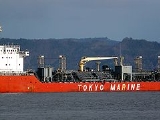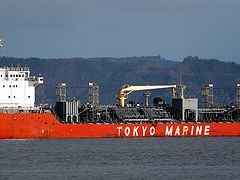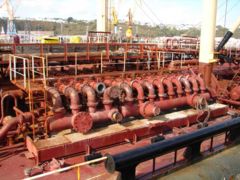
Chemical tanker
Encyclopedia



Tanker (ship)
A tanker is a ship designed to transport liquids in bulk. Major types of tankship include the oil tanker, the chemical tanker, and the liquefied natural gas carrier.-Background:...
designed to transport chemicals in bulk.
Ocean-going chemical tankers generally range from to in size, which is considerably smaller than the average size of other tanker types due to the specialised nature of their cargoes and the size restrictions of the port terminals where they call to load and discharge.
Chemical tankers normally have a series of separate cargo tanks which are either coated with specialised coatings such as phenolic epoxy or zinc paint, or made from stainless steel. The coating or cargo tank material determines what types of cargo a particular tank can carry: stainless steel tanks are required for aggressive acid cargoes such as sulfuric and phosphoric acid, while 'easier' cargoes - e.g. vegetable oil - can be carried in epoxy
Epoxy
Epoxy, also known as polyepoxide, is a thermosetting polymer formed from reaction of an epoxide "resin" with polyamine "hardener". Epoxy has a wide range of applications, including fiber-reinforced plastic materials and general purpose adhesives....
coated tanks.
Cargoes
Chemical tankers often have a system for tank heating in order to maintain the viscosityViscosity
Viscosity is a measure of the resistance of a fluid which is being deformed by either shear or tensile stress. In everyday terms , viscosity is "thickness" or "internal friction". Thus, water is "thin", having a lower viscosity, while honey is "thick", having a higher viscosity...
of certain cargoes - typically this system consists of a boiler which pumps pressurized steam through so-called 'heating coils' - stainless steel pipes - in the cargo tanks, thus transferring heat into the cargo which circulates in the tank by convection. Many modern chemical tankers feature double hull construction and have one tank for each pump with separate piping, which means that each tank can load a separate cargo without any mixing. Tank cleaning after discharging cargo is a very important aspect of chemical tanker operations, because tanks which are not properly cleaned of all cargo residue can adversely affect the purity of the next cargo loaded. Before tanks are cleaned, it is very important that they are properly ventilated and checked to be free of potentially explosive gases.
Empty holds are normally protected against explosion
Explosion
An explosion is a rapid increase in volume and release of energy in an extreme manner, usually with the generation of high temperatures and the release of gases. An explosion creates a shock wave. If the shock wave is a supersonic detonation, then the source of the blast is called a "high explosive"...
by inert gas
Inert gas
An inert gas is a non-reactive gas used during chemical synthesis, chemical analysis, or preservation of reactive materials. Inert gases are selected for specific settings for which they are functionally inert since the cost of the gas and the cost of purifying the gas are usually a consideration...
blankets.
Most new chemical tankers are built by shipbuilders in Japan, Korea or China, with other builders in Turkey, Italy, Germany and Poland.
The chemical tanker market is dominated by several major chemical tanker operators, including Stolt-Nielsen
Stolt-Nielsen
Stolt-Nielsen Limited is a Norwegian-Bermudean shipping and seafood company. The company has its headquarters formally in London although most of its operations are in Rotterdam, it is listed on Oslo Stock Exchange.-Stolt Tankers:...
, Odfjell
Odfjell
Odfjell is a Norwegian shipping company operating seven tank terminals and 96 parcel tankers. The company has its headquarters in Bergen, Norway and is listed on Oslo Stock Exchange.-History:...
, Eitzen Chemical
Eitzen Chemical
Eitzen Chemical is an international shipping company that owns 72, commercial manages additional 12 and has 31 newbuilding chemical tankers. It is the third largest chemical tanker operator by number of vessels in the world. As part of the Eitzen Group it is based in Oslo and listed on the Oslo...
, Clipper Tankers and Berlian Laju Tanker. Charterers - the end users of the ships -include oil majors and specialist chemical companies.
To book space with the "big 3" or other smaller owners, most charterers use a Shipbroker in order to obtain the most competitive freight rate
Freight rate
A freight rate is a price at which a certain cargo is delivered from one point to another. The price depends on the form of the cargo, the mode of transport , the weight of the cargo, and the distance to the delivery destination...
.
See also
- Ship transportShip transportShip transport is watercraft carrying people or goods . Sea transport has been the largest carrier of freight throughout recorded history. Although the importance of sea travel for passengers has decreased due to aviation, it is effective for short trips and pleasure cruises...
- List of tankers

